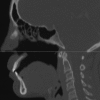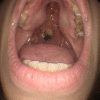Snorting the clivus away: an extreme case of cocaine-induced midline destructive lesion
- PMID: 27797859
- PMCID: PMC5073690
- DOI: 10.1136/bcr-2016-216393
Snorting the clivus away: an extreme case of cocaine-induced midline destructive lesion
Abstract
Cocaine is a drug with relevant socioeconomic and clinical implications, which is usually recreationally used for its stimulant effects. It is widely known that the habit of snorting cocaine is associated with a peculiar type of drug-induced chronic rhinitis, which leads to inflammation of the sinonasal mucosa, slowly progressing to a destruction of nasal, palatal and pharyngeal tissues. These characteristic lesions due to cocaine abuse are commonly called cocaine-induced midline destructive lesions (CIMDL). Diagnosis is not always straightforward, since various conditions, mainly vasculitis, might mimic this acquired condition. The extent of pharyngeal involvement varies, although often a prolonged abuse can trigger a progressive destruction of oral and nasal tissues, with development of infections and recurrent inflammation. Our article focuses on cocaine as a world health problem with important ear, nose and throat implications and discusses the difficulties in diagnosing and treating CIMDL, through a case report.
2016 BMJ Publishing Group Ltd.
Conflict of interest statement
Conflicts of Interest: None declared.
Figures



Similar articles
-
Craniovertebral junction instability as an extension of cocaine-induced midline destructive lesions: case report.J Neurosurg Spine. 2015 Aug;23(2):159-65. doi: 10.3171/2014.11.SPINE1471. Epub 2015 May 8. J Neurosurg Spine. 2015. PMID: 25955800
-
The manifestation of cocaine-induced midline destructive lesion in bone tissue and its identification in human skeletal remains.Forensic Sci Int. 2013 Sep 10;231(1-3):408.e1-11. doi: 10.1016/j.forsciint.2013.04.034. Epub 2013 May 22. Forensic Sci Int. 2013. PMID: 23706264
-
Infective complications of midline destruction in a cocaine user.BMJ Case Rep. 2019 Jul 26;12(7):e231743. doi: 10.1136/bcr-2019-231743. BMJ Case Rep. 2019. PMID: 31350235 Free PMC article. No abstract available.
-
Rare case of naso-oral fistula with extensive osteocartilaginous necrosis secondary to cocaine abuse: review of otorhinolaryngological presentations in cocaine addicts.J Laryngol Otol. 2000 Aug;114(8):630-3. doi: 10.1258/0022215001906345. J Laryngol Otol. 2000. PMID: 11027056 Review.
-
Cocaine-induced midline destructive lesions - an autoimmune disease?Autoimmun Rev. 2013 Feb;12(4):496-500. doi: 10.1016/j.autrev.2012.08.009. Epub 2012 Aug 24. Autoimmun Rev. 2013. PMID: 22940554 Review.
Cited by
-
Non-neoplasic and non-syndromic palatal perforations. Presentation of 5 cases and systematic review of the literature.J Clin Exp Dent. 2021 Sep 1;13(9):e961-e968. doi: 10.4317/jced.58714. eCollection 2021 Sep. J Clin Exp Dent. 2021. PMID: 34603627 Free PMC article.
-
Oral Rehabilitation for a Patient with Cocaine-Induced Midline Destructive Lesions.Case Rep Otolaryngol. 2024 Jun 19;2024:7109261. doi: 10.1155/2024/7109261. eCollection 2024. Case Rep Otolaryngol. 2024. PMID: 38939732 Free PMC article.
-
Comprehensive Management of Cocaine-Induced Midline Destructive Lesions: A Young-IfOS Consensus.J Pers Med. 2025 Jun 3;15(6):231. doi: 10.3390/jpm15060231. J Pers Med. 2025. PMID: 40559094 Free PMC article.
-
Cocaine-Induced Midline Destructive Lesions: A Real Challenge in Oral Rehabilitation.Int J Environ Res Public Health. 2021 Mar 20;18(6):3219. doi: 10.3390/ijerph18063219. Int J Environ Res Public Health. 2021. PMID: 33804629 Free PMC article.
-
Mucocutaneous Manifestations of Recreational Drug Use.Am J Clin Dermatol. 2024 Mar;25(2):281-297. doi: 10.1007/s40257-023-00835-y. Epub 2024 Jan 13. Am J Clin Dermatol. 2024. PMID: 38217568 Review.
References
-
- European Monitoring Centre for Drugs and Drugs Adiction. http://www.emcdda.europa.eu/ (accessed 20 Nov 2015).
-
- Serrano-Sanchez P, Bagan JV, Jimenez-Soriano et al. . Palatal perforations secondary to inhaled cocaine abuse. Presentation of five cases. J Clin Exp Dent 2010;2:e105–9.
-
- Gandara-Rey JM, Diniz-Freitas M, Gandara-Vila P et al. . Lesions of the oral mucosa in cocaine users who apply the drug topically. Med Oral 2002;7:103–7. - PubMed
Publication types
MeSH terms
LinkOut - more resources
Full Text Sources
Other Literature Sources
Medical
